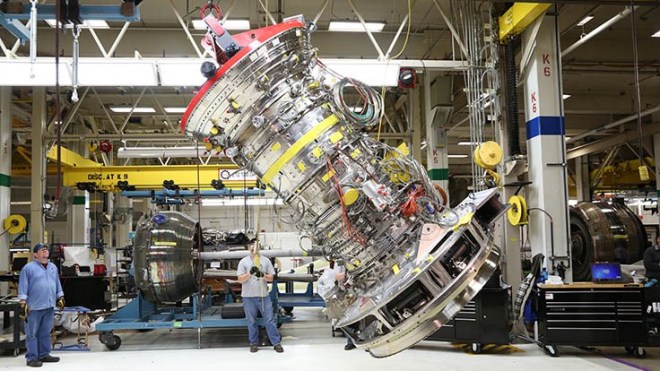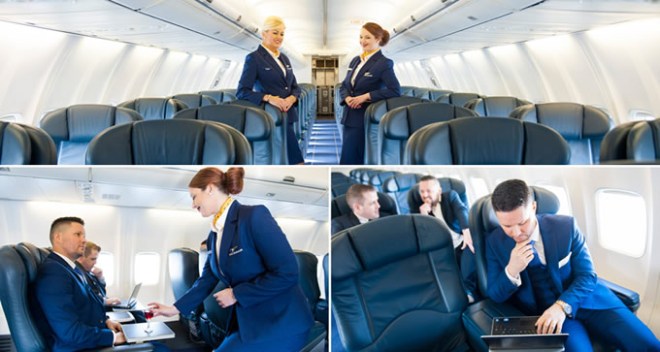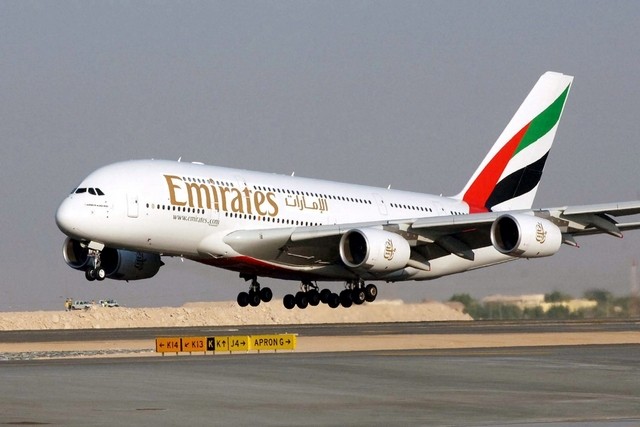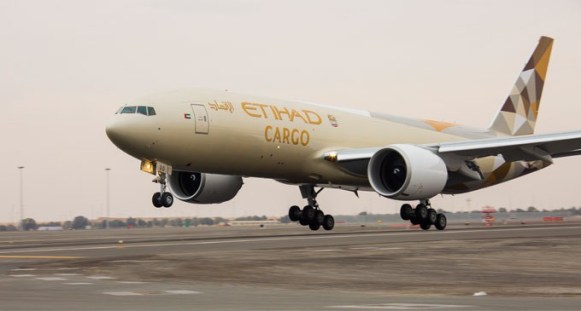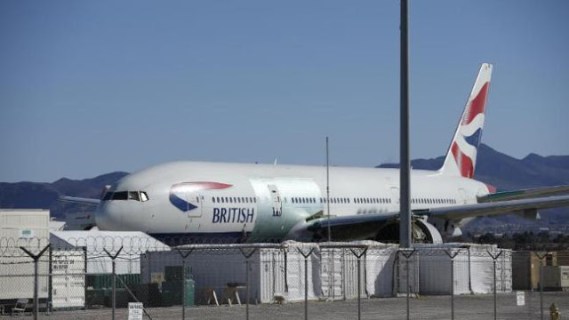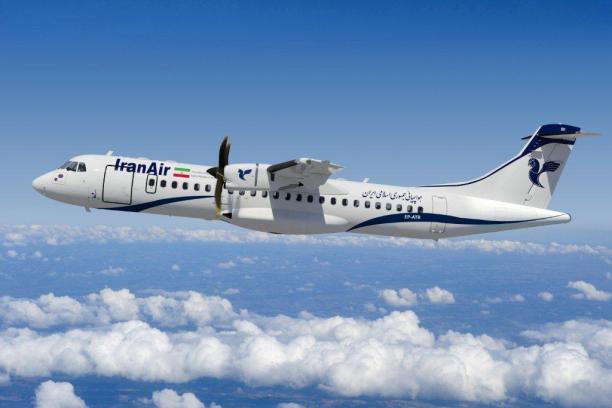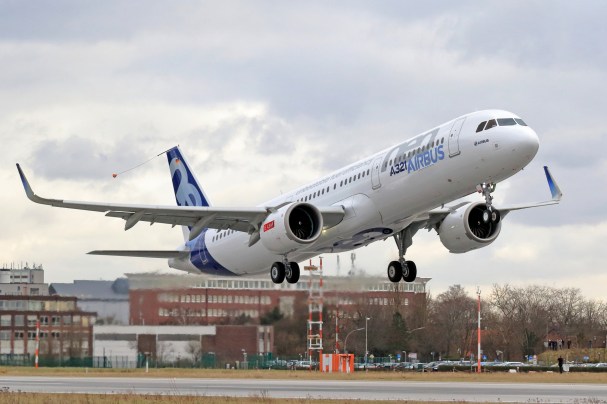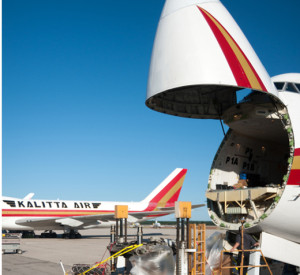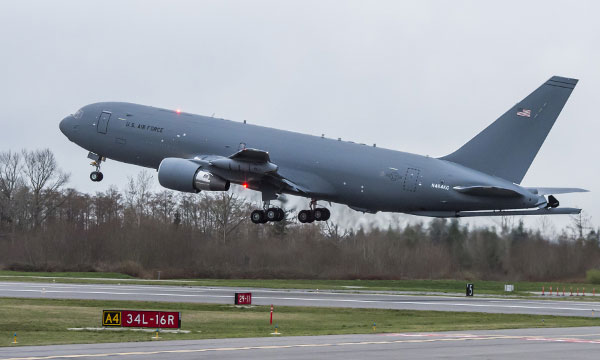ON THE BOEING FRONT
Boeing Launches 737-800 BCF Program
Boeing has launched the 737-800 converted freighter program, with orders and commitments for up to 55 conversions. In a statement, Boeing says the modifications will be done at selected facilities near conversion demand, including Boeing Shanghai.
Modifications required include the installation of a large main-deck cargo door, a cargo-handling system and accommodation for non-flying crew or passengers. The first 737-800 Boeing Converted Freighter is expected to be delivered in the fourth quarter of 2017.
The aircraft will have the capacity to carry up to 52,800 pounds of cargo, and a range of about 2,000nm. Boeing says 12 pallet positions, comprising 11 standard pallets and one half-pallet, will provide 5,000 cubic feet of cargo space on the main deck. There will also be two lower-lobe compartments, which will provide a further 1,540 cubic feet of cargo space.
GECAS will provide the initial aircraft for conversion, and has also ordered five conversions. Hangzhou-based YTO Airlines and Beijing-based China Postal Airlines have meanwhile signed for 10 conversions each. YTO has also committed to 10 additional conversions. An unannounced customer meanwhile has signed for five conversions with two commitments.
Boeing adds that it has also secured a further 13 commitments from China’s SF Airlines, Bulgaria’s Cargo Air, and an unannounced customer. The 737-800 BCF will primarily be used to carry express cargo on domestic routes.
“While the recovery of the global cargo market has been slow, we see demand for freighters, such as the 737-800 BCF, that will carry express cargo on domestic routes,” says Stan Deal, senior vice president, commercial aviation services, Boeing Commercial Airplanes.
Source : Flightglobal/Boeing/Photo Boeing
ON THE AIRBUS FRONT
Airbus Group Lifts A330 Output Goal As Profits Meet Expectations
Airbus Group performed a partial U-turn on plans to cut production of its profitable A330 aircraft on Wednesday February 24th, easing the delicate transition to newer models.
The European plane maker said it now plans to build seven A330 wide body jets per month from 2017; partially unwinding recent staggered cuts in output to six from 10 a month as it prepares for its new A350 jetliner and an A330 upgrade (the A330neo) .
Demand for the current generation of jets such as the 250-to 300-seat A330 faces a broad decline as a new generation of fuel-saving airplanes enters the market.
The move to reconsider the decline of one of its two main sources of cash and profits came weeks after Iran provisionally agreed to buy 45 A330 jets as part of a $27 billion deal following the lifting of sanctions. Airbus said it would have gone ahead anyway because of other deals.
“That should be enough to put a floor under production until a revamped version of the A330 enters service at the end of 2017”, Chief Executive Tom Enders said.
Source : New York Times.90
BUSINESS/REGIONAL NEWS
Embraer Rolls Out E190-E2 Aircraft
Embraer has rolled out its first next-generation E-Jet, an E190-E2, at its factory in Sao Jose dos Campos, Brazil. The E-190-E2’s first flight is slated for the second half of 2016 with first deliveries expected to take place in 2018. The E2s are exclusively powered by Pratt & Whitney PW1900G geared turbofan engines.
Before a crowd of several thousand Embraer employees and invited guests – following flyovers from aircraft from Embraer’s three aviation divisions (commercial jets, executive jets and defense systems) and a welcome greeting from Embraer president and CEO, commercial aviation Paulo Cesar Silva – the doors of hanger F-300 slowly opened to reveal the first assembled prototype of the E190-E2jet, which gradually rolled out onto the tarmac before stopping, its nose several meters away from the gathered crowd.
“The rollout on February 25th marks the completion of the assembly of the first E190-E2 and paves the way for the start of the tests that will lead to first flight,” Embraer SVP operations and COO-commercial aviation Luis Carlos Affonso said.
Four prototypes of the E-190-E2 will be created for the aircraft’s certification process. Assembly of the second prototype is underway; it recently had its wing junction completed, Affonso said.
To date, the E2 program has 640 commitments, comprising 267 firm orders and 373 options and purchase rights.
Source : ATW/Embraer Photo
Gulfstream Starts G600 Systems Testing on Iron Bird
Gulfstream has begun simulated flight tests on the G600 Iron Bird ground rig preparation for the first large-cabin, long-range business.
During the 30 minute “flight”, the Iron Bird-housed at the airframe’s Savannah, Georgia headquarters-simulated taxi, take-off and landing, says Gulfstream. It also performed simulated maneuvers and transitions at different altitudes and airspeeds.
“This first flight sets in motion the testing and validation required for the G600’s actual first flight,” says Dan Nale, Gulfstream’s senior vice-president for programs, engineering and test. ”With the Iron Bird, we can confirm the characteristics of the system components, improve the integration maturity, make modifications and provide those benefits in a lab environment, all while on the ground and still in design stage, to the benefit of the flight-test aircraft.”
Gulfstream says the first G600 flight-test model and structural test vehicle are in production in Savannah.The 6,200nm (11,500km) Pratt & Whitney Canada PW815Ga- powered twin is scheduled to enter service in 2019 – a year behind its shorter-range stablemate, the G500.
Source : Flightglobal/Gulfstream
OTHER AVIATION NEWS
GE Aviation Finishes the Assembly of the First GE9X Test Engine
GE Aviation has completed the assembly of the first GE9X test engine at its Peebles, Ohio facility. It will shortly begin ground runs of the 100,000 kb-thrust (445kN)-class power plant for the 777X.
“The engine is assembled, it is just a matter of adding lots of instrumentation,” says GE9X program manager Bill Millhaem. Tests will begin “soon” he says, although declines to offer a precise date.
The GE9X features a basket of advanced technologies as GE strives to reduce weight and improve engine performance to deliver a 10% reduction in specific fuel burn over the current-generation GE90.
These include use of ceramic matrix composites (CMC) on the inner and outer combusted liners, plus stage 1 and 2 nozzles and stage 1 shroud in the high pressure turbine.
“The first engine to test (FETT) wraps up the extensive technology maturation program for the GE9X engine program. It began five years ago and has included component-level, system-level and core demo testing to validate the advanced technologies and materials in the new engine,” GE said in a statement. The CMC parts have so far performed “phenomenally”,said Millhaem.
The maiden sortie of the GE9X, using a company owned 747-400 flying testbed, is due to take place in mid-2017. Engine certification is scheduled for October 2018.
Source : Flightglobal/GE Aviation
Ryanair to Offer All Business 737-700 for Charter
Budget carrier Ryanair is to offer a Boeing 737-700 for corporate charter services, the aircraft configured with just 60 business class seats.
Ryanair – which acquired a 737-700 last year, indicating it would serve as a back-up and training jet – says that it is offering charter with the type. The carrier’s regular mainline fleet comprises the larger 737-800.
The aircraft will be operated on routes up to 6 hours and the passengers will be offered a cabin fitted with leather seats, at a pitch of 48in, and fine dining on-board catering.
The airline will provide the cockpit and cabin crew. Its a charter for hire division says the aircraft will be made available on a “cost per hour” basis, with overall quotes depending on the departure and arrival airport. “We offer the most competitive rate in Europe,” it said.
Source : Flightglobal/RyanairPhotos
Emirates Tim Clark Blasts Airbus for Confused Strategy On Wide Body Jets
Emirates President Tim Clark faulted Airbus for lacking a coherent strategy on its biggest airliners; saying the plane maker should focus on an upgrade of its A380 super jumbo rather than spend resources on yet another variant of its new A350.
“Airbus’s thinking has become increasingly hard to read and talk further extending the stretched A350-1000 makes little sense”, Clark said on Thursday, March 10th at the ITB travel fair in Berlin. He added that he is not sure the manufacturer could afford to fund the project along the upgraded A380 he is keen to buy.
“There seems to be a certain amount of cloudiness,” Clark said. “They’ve got the A380 and then bingo, out pops the new A350-1000. I am not quite sure how that’s going to pan out.”
As the world’s leading wide body operator, Emirates exerts influence over the models that Airbus and The Boeing Co. develop. The Dubai based carrier has made the A380 the centerpiece of its fleet, adding flourishes such as bars and showers. Emirates is eager to buy as many as 200 upgraded planes, even as a lack of orders from other carriers puts the model’s future in doubt.
Clark is evidently running out of patience after John Leahy, Airbus’s sales chief, said on March 1st, that there’s “nothing imminent” about the A380 re-engining plan and that even if the Neo were available, Emirates is “not in a position to go ahead” until the mid-2020s because of lack of airport space.
Clark said that’s wrong and the Gulf carrier would be happy to take the aircraft from 2021 if Airbus builds it. Airbus said it could not immediately comment.
Airbus’s increasing focus on a double-stretch A350 is of less interest to Emirates because the plane would compete with the largest version of Boeing’s revamped 777X – an aircraft it’s already taking. Clark said a bigger A350 would add weight and create issues at airports from the extra length.
Source : Bloomberg/Emirates
LATEST NEWS IN BRIEF
- Air Canada on February 17th Air Canada announced that it has entered into a Letter of Intent with Bombardier Inc. to acquire up to 75 Bombardier CS300 aircraft powered by Pratt & Whitney PW1500 G engines.
- Etihad Cargo has taken delivery of a new Boeing 777-200 LRF freighter that will enable the freight arm of Etihad Airways to continue its expansion plans into 2016.
- Boeing gets U.S. license to talk deals with Iranian airlines about buying jetliners; but it would need additional U.S. approval to make sales.
- British Airways jet that caught fire in Las Vegas airport last year is being repaired and will reenter service. A team from Boeing carried the repair and the aircraft has flown to Victorville, California for painting.
- Oman Air has agreed to a three year wet leasing deal for two Kenya Airways Boeing 787-8s.
- Ukraine International Airlines will replace its 737 Classic fleet with newer types through the end of 2018. The carrier took delivery of a 737-800 on January 22nd and announced plans to expand the fleet with six of the type this year.
- Iran Air placed a firm order for 20 ATR 72-600s and took options on a further 20, valued at $1.1 billion at list prices.
- Travel Service Czech leisure carrier is aiming to operate 40 Boeing 737-MAX 8s by 2025 and has just leased a further 16 aircraft, increasing its commitment to 25 of the type.
- Air Niugini ordered four Boeing 737 MAX 8 aircraft. The previously unidentified order adds to the Papua New Guinea national carrier’s fleet of Next Generation 737s and 767-300ERs.
- Philippine Airlines signed a memorandum of understanding (MOU) to purchase six A350-900s. The Order is valued at $1.8 billion at list prices.
- Airbus the first Airbus A321neo equipped with CFM International Leap-1A engines completed its maiden flight on February 9th from Hamburg, Germany.
AIR CARGO
Kalitta Air to Diversify with 767 Freighters
Kalitta Air relies on a fleet of 747 freighters for the long-haul flights it is known for carrying large payloads, including heavy machinery, delicate medical equipment, perishable foods, even livestock. So what’s with 767s the cargo carrier is now purchasing? 767s may be the go-to freighters for the integrators, but they’re rare in general freight world.
The answer is a combination of fleet maintenance requirements and a strategy shift at the Michigan-based carrier. “The time is right for Kalitta to develop in the domestic market”, said Pete Sanderlin, the vice president and general manager, and the number two guy behind CEO and owner Conrad “Connie” Kalitta. Right now, Kalitta Air operates thirteen 747 freighters, three of which are 30 years old 747-200s.Sanderlin said it’s getting difficult to secure parts for the -200s,and since five of the 747-400s are tied up in DHL operations,Kalitta Air does not have many freighters available for other business.
The Airline recently purchased four 767-300 passenger aircraft, two of which are being converted to freighters by Bedek in Tel Aviv. ”We got them because we want to diversify,” Sanderlin said, adding that most of Kallita’s work is on the international stage. “We do little in the U.S. domestic market,” he said. But the plan is to test the waters with the new freighters.
Of course, bringing in new freighter type does not mean abandoning the old. In addition to acquiring the 767s, Kallitta Air also plans to expand its fleet with more 747s. In fact, Sanderlin said they are in negotiations right now to purchase another 747-400 freighter.
Kalitta Air is not a huge airline, but with 1,500 employees and almost 20 freighters, it’s not small by any means. In addition to the airplanes, Kallitta Air has its own engine shop, airframe maintenance facility and training facility with three simulators, which Sanderlin said is unmatched by carriers of its size.
Perhaps one reason Kallita Air has continued to thrive is because it does so much in house. Another reason is leadership. ”Connie is very close to the business, very hands on,” Sanderlin said. He added that he and Kalitta make most of the decisions together.
Source : Air Cargo World /Picture Kallitta
MILITARY
Boeing’s Second KC-46A Achieves First Flight
Boeing’s second functional KC-46A has joined the fledgling pegasus fleet as the US Air Force’s next-generation tanker program advances towards a production decision by the Pentagon in April or May.
The fourth engineering and manufacturing development (EMD) aircraft took flight from Boeing’s Paine Field in Washington state on the second of this month and landed at Boeing Field in Seattle.
The company announced the flight in a statement and confirmed that the second 767-2c aircraft (EMD-3) used for FAA and military type certification will join the tanker program in April.
“Adding a second tanker to the flight test program is very important as we move into the next phase of testing,” US Air Force KC-46 system program manager Col. John Newberry says. ”The team will initially use the aircraft to test mission system avionics and exterior lighting. Later, it will share the air refueling effort with the first KC-46.”
Adding the second fully configured tanker will help Boeing move through “receiver certification” for 18 aircraft types. KC-46 has already demonstrated functionality with the Locheed Martin F-16, Boeing F/A-18 and refueling from a Boeing KC-10.
Source : Flightglobal/Boeing
Researched and Compiled by : Ed Kaplanian
Commercial Aviation Advisor
Contact – ed@kaplanianreport.com



